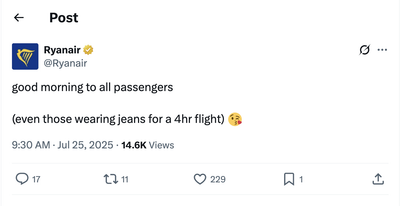Marketing Strategy
Branding
Activations
Social Media
Get to know us
The Role of Tone of Voice in Brand Strategy


Jordan Stachini
Contents
Tone of voice is something we see brands struggle with all the time. The root problem is that people don’t even know what tone of voice is. They think tone is just about choosing a few “on-brand” words or throwing some emojis into a caption. It’s not. Tone of voice is what you say, what you don’t say, how you sound, the way you communicate and it’s an indicator of your character. It’s the way your brand carries itself – and it’s a dead giveaway of whether you’ve got your sh*t together or not.
Your tone of voice should be consistent everywhere – online or offline, written or spoken. Whether someone sees your brand on the side of a bus or scrolling through TikTok, it should always sound like you.
But here’s what most people forget: tone of voice isn’t just for your customers to relate to and identify with. Your internal brand – your culture, your recruitment messaging, all your assets – should reflect it too. Your team are your first brand advocates. If they don’t believe it, no one else will. Treat your people like internal customers. Your employer brand needs to be wedded into your customer brand which is especially key when it comes to recruitment and culture.
At co&co, we’re a no fluff, no bull agency and we can safely say if you bumped into us in town or caught us mid-pint with a Guinness, we’d sound exactly the same as we do online. We’re just straight-up and say it like it is. That’s the goal – your brand should sound like you, wherever it shows up.
Getting your tone of voice right is no longer centered around sounding “professional” or “friendly” or whatever the latest trend is. It’s about sounding like you. Which sounds pretty easy, right? But this is where a lot of people fall short in their brand strategy. When you do get it right, it instantaneously builds trust. That’s what cuts through the noise. And that’s what this article is about – finding your brand’s voice, using it properly, and keeping it consistent so your audience knows exactly who they’re dealing with.
Let’s sort it out.
Defining Your Brand’s Unique Voice
Let’s get straight to it: your tone of voice isn’t just how your brand “talks” – it’s how your brand shows up. It’s what you say, what you don’t say, how you sound, the way you communicate, and an indicator of your character. If that sounds deep, it’s because it is. Tone of voice is your identity.
For most businesses, their tone of voice is a mess. Why? Because they haven’t done the groundwork. If you haven’t figured out who your brand is or what it stands for, your tone is going to be all over the place – random captions, confused messaging, and a whole bunch of “why isn’t this working for us?”. That clarity starts with doing the deep work in building a brand strategy that actually defines your identity.

Understanding Brand Voice
Your brand voice is made up of:
👉 What you say – The messages you put out into the world. Are you bold? Playful? Straight to the point? What topics do you talk about, and what do you stand for? It’s the substance behind your brand story and the reason people should give a sh*t.
👉 What you don’t say – Just as important. Knowing what to leave out shows restraint, clarity, and confidence. Not every brand needs to jump on every trend or join every conversation.
👉 How you sound – This is the tone. Is your voice dry and sarcastic? Warm and reassuring? Loud and bold? It’s the energy behind the words.
👉 The way you communicate – Not just the words, but the delivery. Is it short and snappy or thoughtful and detailed? Are you using emojis, voice notes, memes, or formal language? The format matters just as much as the message.
👉 An indicator of your character – Your tone of voice reflects who you are as a brand. It tells people what you value, what you’re about, and whether they want to f*ck with you or not.
Steps to Define Your Brand Voice
Identify Your Brand DNA
Before you even touch the tone of voice, you need to get your brand DNA sorted. That’s your vision, mission, values, proposition, and tone of voice. Tone of voice is baked into who you are as a brand. You can’t define how you sound until you know what you stand for. If your DNA is vague or half-baked, your tone will be too. And without that, your brand strategy will fall apart.Understand Your Audience
Know who you’re talking to. What do they care about? What winds them up? What do they actually need from you? The goal isn’t to change who you are to please them, it’s to show up as yourself in a way that lands. Speak your truth, in their world. Don’t dumb it down or dress it up – just make sure it hits.Analyse Competitors
No one’s playing it safe anymore – everyone’s shouting for attention. So the question is, how do you stand out? Look at the market, then carve out a voice that stands the f*ck out.Create Voice Guidelines
If it’s not written down, it’s not real. Build a brand strategy guide that captures tone, language do’s and don’ts, and examples that show people how to get it right.
Your brand’s voice should be so dialled in that people recognise you without seeing your logo. That’s when you know you’ve nailed it.

Communicating Effectively with Your Target Audience
Know your audience. Yes we’ve already touched on this a little bit but let’s go into the details. You can have the best tone guidelines in the world, but if your audience doesn’t feel it, it’s pointless.
Importance of Audience Understanding
Your customers aren’t generic ‘users’ – they’re humans with opinions, preferences, and a short attention span. If your tone doesn’t match what they expect (or need), they’ll bounce fast. Get this right, and you’ll build trust that lasts. And trust is the cornerstone of any strong brand strategy.
Strategies for Effective Communication
Personalisation
Don’t sound like you’re reading from a script. Use language that’s direct and relevant to your customer’s life.Consistency Across Channels
Whether it’s your website, social media, or a sweaty conference stand, your tone should always feel like the same person is speaking.Feedback Loops
Want to know if you’re hitting the mark? Ask your customers. Listen to what they say and tweak your tone as you learn.
Benefits of Effective Communication
Enhances customer engagement.
Builds loyalty so they don’t bugger off to your competitors.
Improves satisfaction (because no one likes a confusing message).
Increases conversion rates – because clarity sells.

Maintaining Consistency in Messaging
Nothing makes a brand look more amateur than inconsistency. One minute you’re friendly and approachable, the next you’re the opposite. That kind of identity crisis doesn’t build trust – it raises eyebrows. Customers don’t want to decode who you are every time you show up. If your tone keeps changing, they’ll assume you’re either confused, full of sh*t, or both.
Consistency tells people you’ve got your act together. It shows you know who you are, why you exist, and what you stand for – no matter the channel, campaign, or context. That’s how trust is built: repetition, reliability, and a bit of attitude in the right places.
Think of your brand like a character in a series. If they acted completely different in every episode, you’d switch off. Same goes for your tone of voice. Get it consistent, or get forgotten.
Strategies for Consistent Messaging
🖤 Develop a Style Guide
This is your holy grail. It should outline everything – from tone and voice, to sentence structure, to words you use (and avoid), to how you sign off an email. Formatting rules, punctuation quirks, emoji policies – the lot. The clearer it is, the less room there is for inconsistency. No one on your team should ever be able to say “I didn’t know” when the playbook’s right there in front of them.
🖤 Train Your Team
Even the best guidelines are useless if people don’t read or understand them. Get your people trained up. Show them what good looks like, what bad sounds like, and why tone of voice isn’t just a copywriter’s problem. Everyone needs to understand how your brand talks. And more importantly, why it talks that way. When your team cares, your tone holds.
🖤 Regular Audits
Consistency is a discipline, not a one-off. You don’t set it and forget it. Schedule regular reviews of your website, emails, social posts – anywhere your voice shows up. Spot the slip-ups, fix the gaps, and keep the quality tight. Strategy audits help you see the big picture: where your brand’s speaking clearly, and where it's going rogue. If something doesn’t feel like you, it’s time to rewrite or bin it.
🖤 Use Templates
Templates are there to protect your tone from chaos. A good set of templates for things like emails, proposals, social posts, or even internal comms means the bones of your messaging are always on-brand. You save time, reduce f*ck-ups, and keep things tight, even when the pressure’s on.

Case Studies: Brands Smashing it Right Now
There are a few brands out there that really know what they’re doing all because they know who they are.
Ryanair
Now for something completely different. Unlike Starbucks' soft, motivational tone, Ryanair takes the pi*s –and somehow, it works. Their tone of voice is savage, self-aware, and proudly low-budget, just like the airline. They don’t pretend to be premium. In fact, they lean into being anything but.
They roast their own customers, troll competitors, and jump on trends faster than most brands can even approve a post. Tag them in a photo complaining about a missing window? They’ll quote-tweet it with a brutal comeback. Clap at the end of a flight? They’ll drag you for it publicly. They even take shots at their own service – because they know people still book with them anyway. And why? Because it’s cheap, and they own that completely.
The result? A tone of voice that’s reactive, hilarious, and brutally honest. People don’t follow Ryanair for dreamy travel inspo – they follow to laugh, tag their mates, and feel part of the joke. And in doing so, Ryanair stays hyper-relevant, ultra-shareable, and surprisingly likeable. It’s proof that when you fully commit to your brand personality, your audience will respect it.


Gymshark
Gymshark has nailed a tone of voice that speaks directly to its niche – young gym-heads aged 18 to 30 who live somewhere between PBs and protein shakes. It’s clever, down-to-earth, and bang on for the crowd it’s built for. One scroll and you’ll see content that’s relatable, occasionally funny, and never trying too hard to be “cool” – because it already is.
They’re not afraid to say, “Yeah, we don’t always feel like training either.” Then they’ll flip it and remind you why rest days matter or drop a post that gets you back in the zone. It’s motivational yeah, but it's also human. And that’s exactly why it works.
The voice is confident, self-aware, and always consistent – whether they’re jumping on a TikTok trend or dropping a new range. That consistency is what’s helped them go from lifting in the shadows to competing with global giants like Nike and Adidas.
So if you still think tone of voice doesn’t matter in your brand strategy, take a look at Gymshark’s rise and think again.

Hiscox Insurance
Insurance. B2B. Dull, right? Not even close. Hiscox is proof that even in the most traditional industries, tone of voice can set you apart and make people actually give a sh*t.
While most insurance brands are locked into stiff, legal-sounding nonsense, Hiscox has flipped the script. Their tone is confident, approachable, and refreshingly human. Their social bio says it best: “Some might think insurance is dull – but life at Hiscox is anything but. We ensure the unique and interesting, and our people reflect that.” And this is something they actually live by.
Scroll through their socials and you’ll find “day in the life” videos of their team, behind-the-scenes snippets from inside the office (yes, they have their own café), and content that puts people first. It’s not forced or overproduced – it’s authentic. It sounds like the real people behind the brand are the ones speaking. Because they are.
That’s the power of tone of voice done right – it creates space for individuality. Hiscox doesn’t just push polished brand lines; they let their team speak out, share their stories, and show the culture from the inside. The tone external marketing fluff – it’s part of the internal brand too. Staff are given the freedom to talk like themselves, and that says a lot about what the company values: trust, openness, and a serious commitment to work-life balance.
And it all ladders back up to strategy. Hiscox proves that tone is about attracting the right talent, building a loyal community, and showing the world that you don’t need to sound boring just because your product or service is deemed “serious.” Their tone makes them memorable, relatable, and way more trustworthy than the rest of the industry’s beige wall of noise.
Bottom line: if Hiscox can make insurance feel human, your brand has no excuse.

Tone of voice isn’t just the icing on the cake – it is the cake. A clear, consistent, and genuine tone shows your audience you know who you are and why you matter. It helps you build real connections, communicate your values, and stand out in a marketplace stuffed full of brands that all sound the same.
Ready to give your brand a voice that works for you? Hit us up. We’ll help you develop a tone that makes your audience care.

Speak to Jordan today
Grab a brew. Have a read
You might also like...






